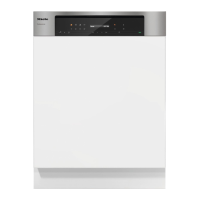Installation
*INSTALLATION*
86
The Miele Waterproof system
As long as your dishwasher has been
installed correctly, the Miele waterproof
anti-leak system will provide extensive
protection against water damage
throughout its lifetime.
Water inlet
Water in the dishwasher must
not be used as drinking water.
- The dishwasher must be connected
to the water supply in strict
accordance with current local and
national water authority regulations.
- The water used must at least comply
with European regulations for
drinking water quality.
If the water supply has a high iron
content, there is a danger of
corrosion occurring on items being
cleaned in the dishwasher, as well as
the appliance itself.
If the chloride content of the water
exceeds 100mg/l, the risk of
corrosion to items being cleaned in
the dishwasher will be further
increased.
- In certain regions (e.g. mountainous
regions), the water composition may
cause precipitates to form, requiring
the use of softened water for the
dishwasher.
- The dishwasher complies with all
valid European standards on the
protection of drinking water.
- The water pressure (flow pressure at
the water connection) must be
between 50 and 1000kPa (0.5 and
10bar).
If the water pressure is lower than
this, the fault message Water intake
will appear in the display (see
“Problem solving guide”).
If the water pressure is too high, a
pressure reducing valve must be
fitted.
- A stopcock valve with a
3
/
4
inch
threaded union must be provided on
site. The valve should be easily
accessible, since the water inlet
should be shut off whenever the
appliance is not in use.
- The DN10 inlet hose is approx. 1.5m
long terminating in a
3
/
4
inch screw
thread. A 1.5m long flexible metal
extension hose tested to 140bar
(14,000kPa) is available as an
optional accessory if required. On no
account may the inlet filter or the flow
regulator in the screw thread be
removed.

